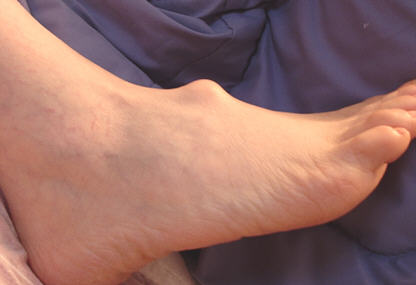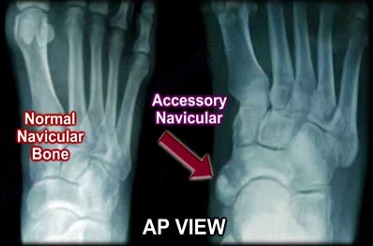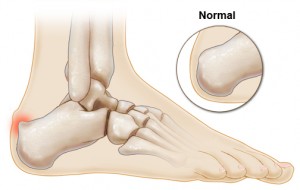


A lump on your foot could be due to many reasons, like corns, calluses and blisters. Sometimes, however, it may be due to a bone deformity called saddle bone deformity. Below we will discuss this particular issue and other bone-related foot lumps.

Saddle bone deformity, also known as metatarsal cuneiform exostosis, begins to occur in a person between 25 to 26 years of age and is caused by hyper-mobility in your first metatarsal cuneiform joint. This joint is made of three adjacent bones in the mid-foot that lead to the base of each toe. The build-up of bone on this joint finally leads to this condition.
It begins as a painful and easily distinguishable lump on the upper surface of the foot. When left alone, this lump may not cause any discomfort but inappropriate footwear can quickly aggravate the situation. Closed-toe shoes will apply pressure on the growth and on the nerve directly below it, causing pain in the first and second toes. Open-toe shoes will be comfortable for people suffering with this deformity.
The presence of a distinct lump on the foot could indicate the said deformity, regardless of whether it pains or not. An easy way to self-assess is a test called Tinel’s sign. This can be performed by gently tapping the bump with the index and middle fingers. You will have a tingling feeling near the top of the foot or in the toes if you do have saddle bone deformity because the deformity cause the saddle bone to apply pressure on the peroneal nerve. Your medical care provider can then ascertain the need for medical intervention with an X-ray.
It is not very difficult to live with this deformity.
Open-toe footwear like flip-flops or sandals should be worn wherever possible. If closed-toe option is a requirement, then products like foam metatarsal pads, compression sleeves, wedges and supports for the sole can be placed in the shoe to prevent complications. There are a variety of products available in the market, so it is important to get a professional medical opinion and try different options.
This deformity can also be treated with surgery. A surgical treatment will remove the build-up of bone, known as saddle bone or exostosis. It can be performed in an hour by an experienced orthopaedic surgeon or a podiatrist. Patients will be able to stand on the foot immediately after the procedure, while full function of the foot can be achieved only after few weeks. Doctors may advise the use of open-toe footwear in the weeks leading up to the surgery to prevent any unnecessary pressure on the deformity.
Besides saddle bone deformity, there are some other bumps that can be formed on the foot due to bone deformities. Here are four of these:
 The first bone condition after saddle bone deformity is bunions. Bunions form on the joint attached to the big toe. This bone deformity occurs when the big toe exerts pressure on the adjacent toe, causing the joint of the big toe to expand and push outward. The skin around a bunion generally reddens and is painful. Tight shoes can cause the toes to push together to create bunions and further use will aggravate the situation. An inherited deformity, excessive pressure on the foot or a pre-existing medical condition, like arthritis, can also lead to bunions.
The first bone condition after saddle bone deformity is bunions. Bunions form on the joint attached to the big toe. This bone deformity occurs when the big toe exerts pressure on the adjacent toe, causing the joint of the big toe to expand and push outward. The skin around a bunion generally reddens and is painful. Tight shoes can cause the toes to push together to create bunions and further use will aggravate the situation. An inherited deformity, excessive pressure on the foot or a pre-existing medical condition, like arthritis, can also lead to bunions.
Smaller bunions can form on the joints of the little toes and are known as bunionettes or Tailor’s bunion. It is very similar to other bunions except for its location. The name is derived from an ancient idea that the sitting posture of tailors would cause bunionettes. Like bunions, tailor’s bunions occur when the little toe pushes against the adjacent toe causing the attached joint to protrude outward. It causes the little toe to inflame, ache and redden. It is easy to visually diagnose this condition but X-rays are used to understand its severity.
 Unlike saddle bone deformity, this condition is on the side of the feet. The accessory navicular is a congenital formation of an extra bone or piece of cartilage on the inner side of the foot. Most people are unaware of this deformity unless they experience pain due to it, and this condition is known as accessory navicular syndrome. This formation can be aggravated by certain foot trauma, repeated irritation rom shoes or excessive physical activity. People with flat feet are more prone to developing pain as more strain is exerted on the posterior tibial tendon. Symptoms of this condition become prominent during adolescence, including throbbing in the midfoot and arch, especially after running or jumping, a bony protrusion on the midfoot just above the arch, and swelling and redness of the bony protrusion.
Unlike saddle bone deformity, this condition is on the side of the feet. The accessory navicular is a congenital formation of an extra bone or piece of cartilage on the inner side of the foot. Most people are unaware of this deformity unless they experience pain due to it, and this condition is known as accessory navicular syndrome. This formation can be aggravated by certain foot trauma, repeated irritation rom shoes or excessive physical activity. People with flat feet are more prone to developing pain as more strain is exerted on the posterior tibial tendon. Symptoms of this condition become prominent during adolescence, including throbbing in the midfoot and arch, especially after running or jumping, a bony protrusion on the midfoot just above the arch, and swelling and redness of the bony protrusion.
 Haglund’s deformity is a bone deformity on the back of the heel. The likelihood of its occurrence depends on the shape of the heel bone and the use of stiff heels. The soft tissue behind the heel is irritated when the bony lump brushes against stiff shoes, leading to an inflammation of the fluid-filled portion between the bone and tendon. Inflammation of the heel leads to calcium build-up in the bone, making the lump larger and more painful.
Haglund’s deformity is a bone deformity on the back of the heel. The likelihood of its occurrence depends on the shape of the heel bone and the use of stiff heels. The soft tissue behind the heel is irritated when the bony lump brushes against stiff shoes, leading to an inflammation of the fluid-filled portion between the bone and tendon. Inflammation of the heel leads to calcium build-up in the bone, making the lump larger and more painful.
The possibility of its occurring in women using pump-style high heels has led to the nickname “pump bump”. A high foot arch, tendency to walk on the outer part of the heel or a tight Achilles tendon, the bony section of the heel, can increase the chances of Haglund’s deformity.
Saddle bone deformity itself causes no pain. But symptoms of Haglund’s deformity include excessive pain around the region where the Achilles tendon meets the heel, reddening around the soft tissue of the heel, a bony protrusion behind the heel, and inflammation of the fluid-filled sac at the back of the heel.
Note: A bump on the foot may not be a skin issue, but a bone problem like saddle bone deformity. So it's important to get a medical opinion when you notice an abnormally hard bump.